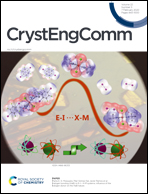Manipulating clusters by regulating N,O chelating ligands: structures and multistep assembly mechanisms†
Abstract
We obtained a binuclear Gd(III) complex [Gd2(L1)2(NO3)4] (1, HL1 = (E)-2-(2-(pyridin-2-ylmethyleneamino)ethoxy)ethanol) by reacting N2O2-tetradentate chelating ligand HL1 with Gd(NO3)3·6H2O at solvothermal temperature of 100 °C. Time-dependent high-resolution electrospray ionization mass spectrometry (HRESI-MS) followed the formation of 1 and revealed it's the assembly mechanism: HL1 → Gd(L1) → Gd2(L1)2. When we used the NO2-tridentate chelating ligand HL2 (HL2 = 2-(2-aminoethoxy)ethanol) under the same reaction conditions, we obtained an “hourglass-like” nonanuclear Gd(III) cluster [Gd9(L2)8(μ3-OH)8(μ4-O)2(NO3)8]·2CH3OH·H2O (2). Their assembly mechanism was proposed: HL2 → Gd(L2) → Gd2(L2)2 → Gd3(L2)3 → Gd4(L2)4 → Gd5(L2)4 → Gd9(L2)8. Most notably, when we used the NO-bidentate chelate ligand HL3 (HL3 = picolinic acid), we obtained a dodecanuclear Gd(III) cluster [Gd12(L3)8(OH)16(NO3)8(OH)4(H2O)4]·22CH3OH·25CH3CN (3) under the same reaction conditions. We found that the formation process of cluster 3 involved two different and mutually interfering self-assembly processes, namely, multitemplate-induced assembly (HL3 → Gd(L3) → Gd2(L3)2 → Gd12(L3)8) and stepwise assembly (HL3 → Gd(L3) → Gd2(L3)2 → Gd3(L3)2 → Gd4(L3)2 → Gd5(L3)2 → Gd6(L3)2 → Gd12(L3)8).



 Please wait while we load your content...
Please wait while we load your content...